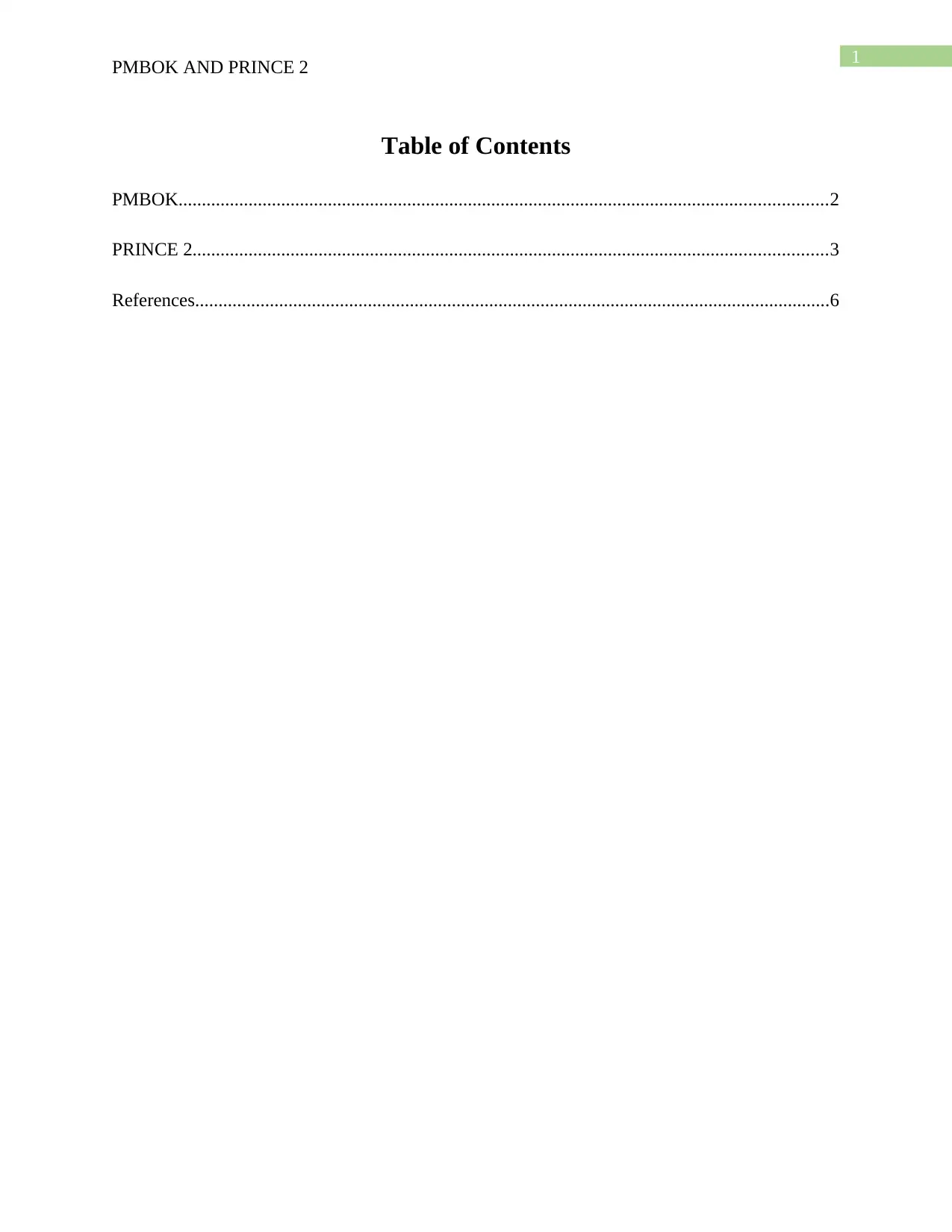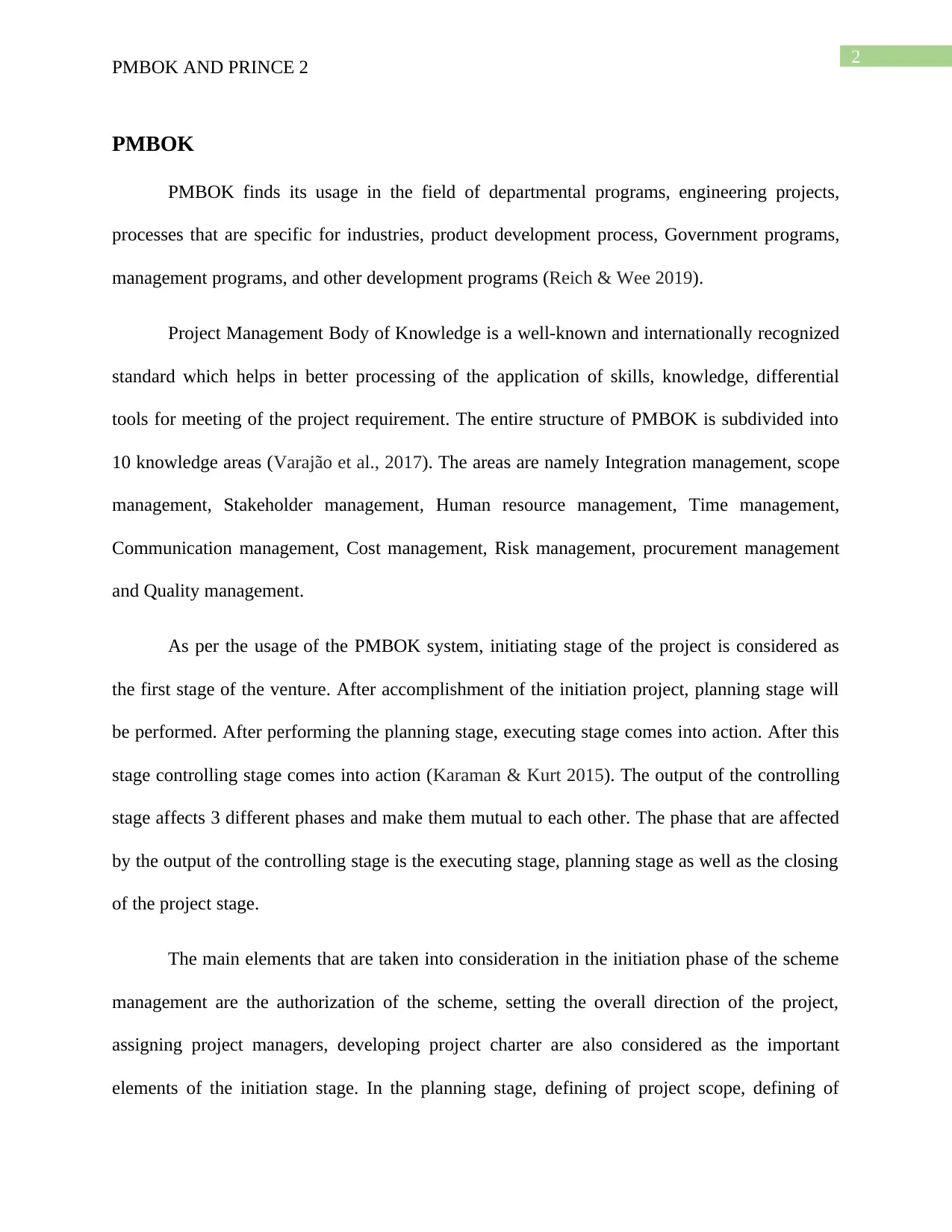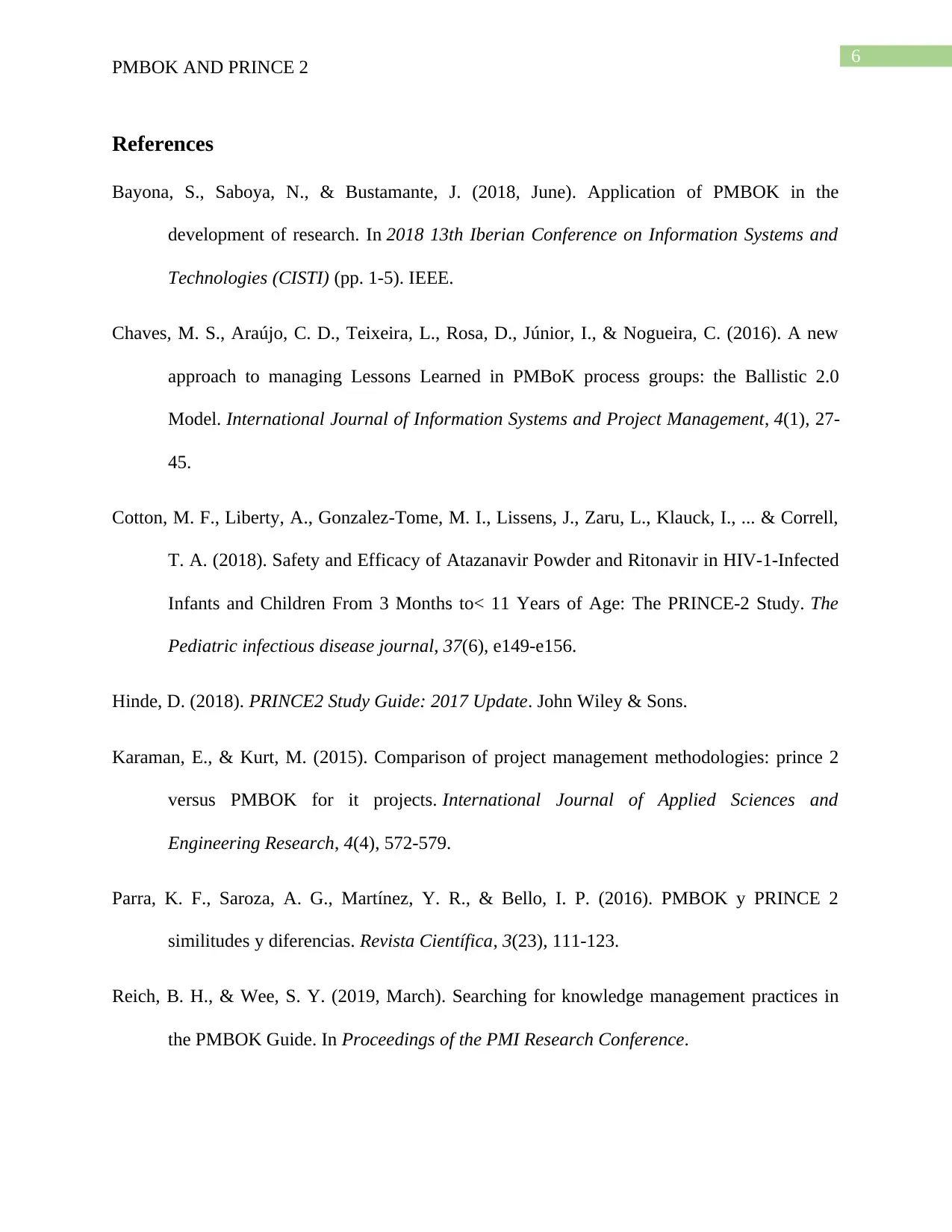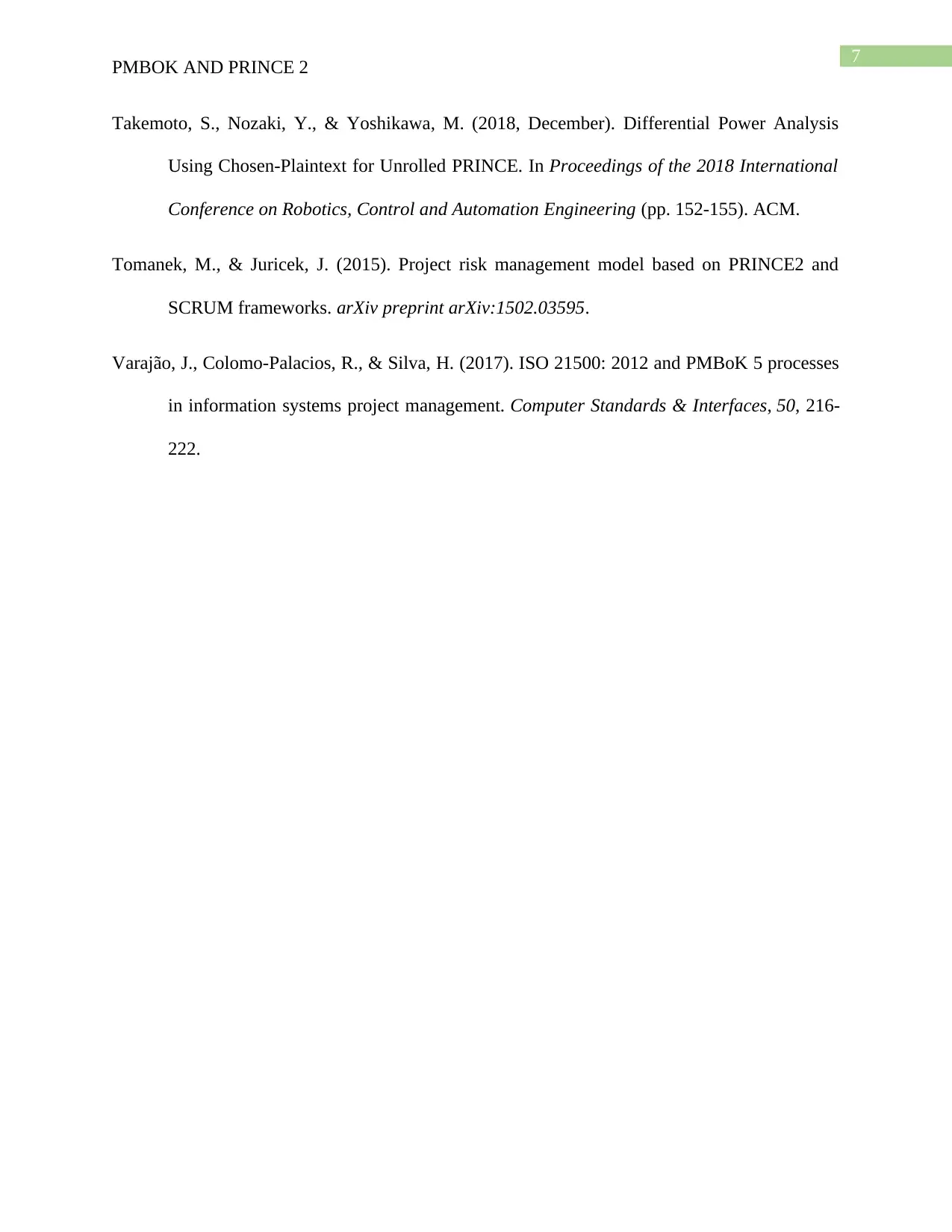An Analysis of PMBOK and PRINCE 2 Project Management Frameworks
VerifiedAdded on 2023/01/16
|8
|1463
|72
Report
AI Summary
This report provides a comparative analysis of two prominent project management methodologies: PMBOK (Project Management Body of Knowledge) and PRINCE 2 (Projects IN Controlled Environments). The report begins by outlining the core principles, structure, and application of PMBOK, including its 10 knowledge areas such as integration, scope, and risk management, along with the different project stages, i.e., initiation, planning, execution, controlling, and closing. It then delves into the PRINCE 2 framework, highlighting its structured approach, the six aspects considered (tolerance types and project levels), and its seven core principles, such as continued business justification, learning from experience, and managing by stages. The report also examines the strengths and weaknesses of both methodologies, providing a comprehensive overview of their respective merits and limitations. It concludes by summarizing the key differences and similarities between the two frameworks, offering insights into their practical application within different project environments and emphasizing their impact on project success.

Running head: PMBOK AND PRINCE 2
PMBOK AND PRINCE 2
Name of the Student
Name of the University
Author note
PMBOK AND PRINCE 2
Name of the Student
Name of the University
Author note
Paraphrase This Document
Need a fresh take? Get an instant paraphrase of this document with our AI Paraphraser

1
PMBOK AND PRINCE 2
Table of Contents
PMBOK...........................................................................................................................................2
PRINCE 2........................................................................................................................................3
References........................................................................................................................................6
PMBOK AND PRINCE 2
Table of Contents
PMBOK...........................................................................................................................................2
PRINCE 2........................................................................................................................................3
References........................................................................................................................................6

2
PMBOK AND PRINCE 2
PMBOK
PMBOK finds its usage in the field of departmental programs, engineering projects,
processes that are specific for industries, product development process, Government programs,
management programs, and other development programs (Reich & Wee 2019).
Project Management Body of Knowledge is a well-known and internationally recognized
standard which helps in better processing of the application of skills, knowledge, differential
tools for meeting of the project requirement. The entire structure of PMBOK is subdivided into
10 knowledge areas (Varajão et al., 2017). The areas are namely Integration management, scope
management, Stakeholder management, Human resource management, Time management,
Communication management, Cost management, Risk management, procurement management
and Quality management.
As per the usage of the PMBOK system, initiating stage of the project is considered as
the first stage of the venture. After accomplishment of the initiation project, planning stage will
be performed. After performing the planning stage, executing stage comes into action. After this
stage controlling stage comes into action (Karaman & Kurt 2015). The output of the controlling
stage affects 3 different phases and make them mutual to each other. The phase that are affected
by the output of the controlling stage is the executing stage, planning stage as well as the closing
of the project stage.
The main elements that are taken into consideration in the initiation phase of the scheme
management are the authorization of the scheme, setting the overall direction of the project,
assigning project managers, developing project charter are also considered as the important
elements of the initiation stage. In the planning stage, defining of project scope, defining of
PMBOK AND PRINCE 2
PMBOK
PMBOK finds its usage in the field of departmental programs, engineering projects,
processes that are specific for industries, product development process, Government programs,
management programs, and other development programs (Reich & Wee 2019).
Project Management Body of Knowledge is a well-known and internationally recognized
standard which helps in better processing of the application of skills, knowledge, differential
tools for meeting of the project requirement. The entire structure of PMBOK is subdivided into
10 knowledge areas (Varajão et al., 2017). The areas are namely Integration management, scope
management, Stakeholder management, Human resource management, Time management,
Communication management, Cost management, Risk management, procurement management
and Quality management.
As per the usage of the PMBOK system, initiating stage of the project is considered as
the first stage of the venture. After accomplishment of the initiation project, planning stage will
be performed. After performing the planning stage, executing stage comes into action. After this
stage controlling stage comes into action (Karaman & Kurt 2015). The output of the controlling
stage affects 3 different phases and make them mutual to each other. The phase that are affected
by the output of the controlling stage is the executing stage, planning stage as well as the closing
of the project stage.
The main elements that are taken into consideration in the initiation phase of the scheme
management are the authorization of the scheme, setting the overall direction of the project,
assigning project managers, developing project charter are also considered as the important
elements of the initiation stage. In the planning stage, defining of project scope, defining of
⊘ This is a preview!⊘
Do you want full access?
Subscribe today to unlock all pages.

Trusted by 1+ million students worldwide

3
PMBOK AND PRINCE 2
project objectives and the required variables, creation of the framework of the project,
sequencing of all the activities, performing the risk assessment plan and communication plan are
the major elements of the planning stage (Chaves et al., 2016). In the execution stage,
coordinating of the resources, performing quality assurance, selection of the subcontractor
approach and working of the plan is provided higher importance as per the elements of the
project. In the monitoring phase, managing of the stakeholders, measuring progresses, taking
corrective actions and issue resolution, change request management and risk management are
performed. Closing stage comprises confirming of the accomplishments, organisational close out
and agreement close out is performed.
The strengths and weaknesses of PMBOK are as follows:-
Strengths
PMBOK is a de facto standard
This process is process oriented
PMBOK also helps in managing the life cycle as per the project, program and portfolio as
per this process (Bayona, Saboya & Bustamante 2018)
Weakness
Implementation of PMBOK acts complex for small projects Area industry as per the functional system has least scope of development.
PRINCE 2
Project IN Controlled Environments has been a structured project management system
that enables better assessment of the practitioner certification program. The main objective
PMBOK AND PRINCE 2
project objectives and the required variables, creation of the framework of the project,
sequencing of all the activities, performing the risk assessment plan and communication plan are
the major elements of the planning stage (Chaves et al., 2016). In the execution stage,
coordinating of the resources, performing quality assurance, selection of the subcontractor
approach and working of the plan is provided higher importance as per the elements of the
project. In the monitoring phase, managing of the stakeholders, measuring progresses, taking
corrective actions and issue resolution, change request management and risk management are
performed. Closing stage comprises confirming of the accomplishments, organisational close out
and agreement close out is performed.
The strengths and weaknesses of PMBOK are as follows:-
Strengths
PMBOK is a de facto standard
This process is process oriented
PMBOK also helps in managing the life cycle as per the project, program and portfolio as
per this process (Bayona, Saboya & Bustamante 2018)
Weakness
Implementation of PMBOK acts complex for small projects Area industry as per the functional system has least scope of development.
PRINCE 2
Project IN Controlled Environments has been a structured project management system
that enables better assessment of the practitioner certification program. The main objective
Paraphrase This Document
Need a fresh take? Get an instant paraphrase of this document with our AI Paraphraser

4
PMBOK AND PRINCE 2
PRINCE 2 is to subdivide the project in manageable parts and perform the management process
(Hinde, 2018). The six aspects that are taken into consideration for the PRINCE2 project are also
sub divided under 2 broad headings (Parra et al., 2016). The headings are namely Tolerance type
and the project levels.
In the section of tolerance types project scope is collaborated with the Project plan that is
present under the heading of project level. Tolerance type time scale is collaborated with the
project level project plan. Tolerance type Risk is collaborated with the project level risk
management approach, Tolerance type quality is collaborated with the project level project
product description, Tolerance type benefits is collaborated with the project level business case
(Cotton et al., 2015). Tolerance type cost is collaborated with project level project plan.
Seven principles that re taken into consideration are as follows: -
Continued business justification: Continued business justification ensures the fact that
processing of the entire system is project in iterative levels. Output of projects are
delivered step wise. This helps in understanding the sustainability of the project
Learn from experience: Relating the data management as per the previously performed
projects. With proper experience gathering accuracy of the project can get better.
Defined roles and responsibilities: Roles of each and every employee is distinguished
and the protagonists are diversified in 4 stages, namely corporate administration, project
board, project administrator level and team level (Tomanek & Juricek 2015).
Manage by stages: Diversification of stages ensures the fact that the management of
each and every step includes better management and this process is performed as per the
steps that are present in the functioning of the process as per steps.
PMBOK AND PRINCE 2
PRINCE 2 is to subdivide the project in manageable parts and perform the management process
(Hinde, 2018). The six aspects that are taken into consideration for the PRINCE2 project are also
sub divided under 2 broad headings (Parra et al., 2016). The headings are namely Tolerance type
and the project levels.
In the section of tolerance types project scope is collaborated with the Project plan that is
present under the heading of project level. Tolerance type time scale is collaborated with the
project level project plan. Tolerance type Risk is collaborated with the project level risk
management approach, Tolerance type quality is collaborated with the project level project
product description, Tolerance type benefits is collaborated with the project level business case
(Cotton et al., 2015). Tolerance type cost is collaborated with project level project plan.
Seven principles that re taken into consideration are as follows: -
Continued business justification: Continued business justification ensures the fact that
processing of the entire system is project in iterative levels. Output of projects are
delivered step wise. This helps in understanding the sustainability of the project
Learn from experience: Relating the data management as per the previously performed
projects. With proper experience gathering accuracy of the project can get better.
Defined roles and responsibilities: Roles of each and every employee is distinguished
and the protagonists are diversified in 4 stages, namely corporate administration, project
board, project administrator level and team level (Tomanek & Juricek 2015).
Manage by stages: Diversification of stages ensures the fact that the management of
each and every step includes better management and this process is performed as per the
steps that are present in the functioning of the process as per steps.

5
PMBOK AND PRINCE 2
Manage by exception: PRINCE 2 project has a well-defined tolerance process. For each
step establishing of the forecasting of the delegated authority is performed.
Focus on products: PRINCE 2 mainly emphases on the explanation and conveyance of
products. Hence delivery of quality products are one of the major advantage that in
provided by PRINCE 2 (Takemoto et al., 2018)
Tailor to suit project environment: PRINCE 2 is considered as per the size,
complexity, time compatibility and risk assessment of the project.
PMBOK AND PRINCE 2
Manage by exception: PRINCE 2 project has a well-defined tolerance process. For each
step establishing of the forecasting of the delegated authority is performed.
Focus on products: PRINCE 2 mainly emphases on the explanation and conveyance of
products. Hence delivery of quality products are one of the major advantage that in
provided by PRINCE 2 (Takemoto et al., 2018)
Tailor to suit project environment: PRINCE 2 is considered as per the size,
complexity, time compatibility and risk assessment of the project.
⊘ This is a preview!⊘
Do you want full access?
Subscribe today to unlock all pages.

Trusted by 1+ million students worldwide

6
PMBOK AND PRINCE 2
References
Bayona, S., Saboya, N., & Bustamante, J. (2018, June). Application of PMBOK in the
development of research. In 2018 13th Iberian Conference on Information Systems and
Technologies (CISTI) (pp. 1-5). IEEE.
Chaves, M. S., Araújo, C. D., Teixeira, L., Rosa, D., Júnior, I., & Nogueira, C. (2016). A new
approach to managing Lessons Learned in PMBoK process groups: the Ballistic 2.0
Model. International Journal of Information Systems and Project Management, 4(1), 27-
45.
Cotton, M. F., Liberty, A., Gonzalez-Tome, M. I., Lissens, J., Zaru, L., Klauck, I., ... & Correll,
T. A. (2018). Safety and Efficacy of Atazanavir Powder and Ritonavir in HIV-1-Infected
Infants and Children From 3 Months to< 11 Years of Age: The PRINCE-2 Study. The
Pediatric infectious disease journal, 37(6), e149-e156.
Hinde, D. (2018). PRINCE2 Study Guide: 2017 Update. John Wiley & Sons.
Karaman, E., & Kurt, M. (2015). Comparison of project management methodologies: prince 2
versus PMBOK for it projects. International Journal of Applied Sciences and
Engineering Research, 4(4), 572-579.
Parra, K. F., Saroza, A. G., Martínez, Y. R., & Bello, I. P. (2016). PMBOK y PRINCE 2
similitudes y diferencias. Revista Científica, 3(23), 111-123.
Reich, B. H., & Wee, S. Y. (2019, March). Searching for knowledge management practices in
the PMBOK Guide. In Proceedings of the PMI Research Conference.
PMBOK AND PRINCE 2
References
Bayona, S., Saboya, N., & Bustamante, J. (2018, June). Application of PMBOK in the
development of research. In 2018 13th Iberian Conference on Information Systems and
Technologies (CISTI) (pp. 1-5). IEEE.
Chaves, M. S., Araújo, C. D., Teixeira, L., Rosa, D., Júnior, I., & Nogueira, C. (2016). A new
approach to managing Lessons Learned in PMBoK process groups: the Ballistic 2.0
Model. International Journal of Information Systems and Project Management, 4(1), 27-
45.
Cotton, M. F., Liberty, A., Gonzalez-Tome, M. I., Lissens, J., Zaru, L., Klauck, I., ... & Correll,
T. A. (2018). Safety and Efficacy of Atazanavir Powder and Ritonavir in HIV-1-Infected
Infants and Children From 3 Months to< 11 Years of Age: The PRINCE-2 Study. The
Pediatric infectious disease journal, 37(6), e149-e156.
Hinde, D. (2018). PRINCE2 Study Guide: 2017 Update. John Wiley & Sons.
Karaman, E., & Kurt, M. (2015). Comparison of project management methodologies: prince 2
versus PMBOK for it projects. International Journal of Applied Sciences and
Engineering Research, 4(4), 572-579.
Parra, K. F., Saroza, A. G., Martínez, Y. R., & Bello, I. P. (2016). PMBOK y PRINCE 2
similitudes y diferencias. Revista Científica, 3(23), 111-123.
Reich, B. H., & Wee, S. Y. (2019, March). Searching for knowledge management practices in
the PMBOK Guide. In Proceedings of the PMI Research Conference.
Paraphrase This Document
Need a fresh take? Get an instant paraphrase of this document with our AI Paraphraser

7
PMBOK AND PRINCE 2
Takemoto, S., Nozaki, Y., & Yoshikawa, M. (2018, December). Differential Power Analysis
Using Chosen-Plaintext for Unrolled PRINCE. In Proceedings of the 2018 International
Conference on Robotics, Control and Automation Engineering (pp. 152-155). ACM.
Tomanek, M., & Juricek, J. (2015). Project risk management model based on PRINCE2 and
SCRUM frameworks. arXiv preprint arXiv:1502.03595.
Varajão, J., Colomo-Palacios, R., & Silva, H. (2017). ISO 21500: 2012 and PMBoK 5 processes
in information systems project management. Computer Standards & Interfaces, 50, 216-
222.
PMBOK AND PRINCE 2
Takemoto, S., Nozaki, Y., & Yoshikawa, M. (2018, December). Differential Power Analysis
Using Chosen-Plaintext for Unrolled PRINCE. In Proceedings of the 2018 International
Conference on Robotics, Control and Automation Engineering (pp. 152-155). ACM.
Tomanek, M., & Juricek, J. (2015). Project risk management model based on PRINCE2 and
SCRUM frameworks. arXiv preprint arXiv:1502.03595.
Varajão, J., Colomo-Palacios, R., & Silva, H. (2017). ISO 21500: 2012 and PMBoK 5 processes
in information systems project management. Computer Standards & Interfaces, 50, 216-
222.
1 out of 8
Related Documents
Your All-in-One AI-Powered Toolkit for Academic Success.
+13062052269
info@desklib.com
Available 24*7 on WhatsApp / Email
![[object Object]](/_next/static/media/star-bottom.7253800d.svg)
Unlock your academic potential
Copyright © 2020–2025 A2Z Services. All Rights Reserved. Developed and managed by ZUCOL.





